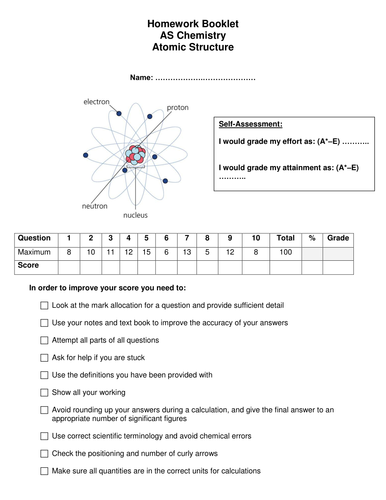
















Using the specification and books
No exam questions are included due to copy right
Including:
Homework booklets
Assessment sheets
Interactive powerpoints (rarely seen in A-level)
1. The atom
2. Atomic models (developing ideas from GCSE)
3. Relative mass, relative atomic mass and atomic number
4 Mass spectrometer
5. Mass spectrum analysis - using mass spectra
6. Electron structure - shells and sub-level (s, p, d, f)
7. Ionisation energies - trends and equations
LESSON 1: FUNDAMENTAL PARTICLES
To appreciate that the knowledge and understanding of atomic structure has evolved over time
To describe the properties of p, n and e in terms of relative charges and mass
To know that early models of the atomic structure predicted that atoms and ions with noble gas electron arrangements should be stable
LESSON 2: Isotopes
To explain the existence of isotopes
To determine the relative atomic mass of elements using isotope abundance data
To understand the physical and chemical properties of different isotopes
LESSON 3: MASS SPECTROMETER
To recall how to calculate the Ar and Mr
To understand the m/z ratio
To know how a mass spectrometer operates
LESSON 4: MASS SPECTRA ANALYSIS
To understand how to interpret a mass spectrum and calculate relative atomic mass
To understand how to work out the relative molecular/formula mass
To consolidate with questions
LESSON 5: ELECTRON CONFIGURATION OVER 2 LESSONS
To understand the electron configuration of atoms and ions
To be able to write the electron configuration of atoms up to Z=36 in terms of levels and sub-levels (orbitals) s, p and d
To understand that there are exceptions to the rules for ions and certain elements
LESSON 7: IONISATION ENERGIES
To state the definition of ionisation energies
To describe the trend in ionisation energies a) down a group and b) across a period in terms of electron configurations
To explain how trends in ionisation energies provide evidence for the existence of electron energy levels and sub-levels
ENJOY!!!
Please rate and comment in order to further improve
Something went wrong, please try again later.
Excellent resource, has made my transition to a-level chemistry teacher considerably less stressful. Would be interested in an a2 organics bundle if any available
I am loving your resources, especially as a new teacher. May I ask what context you use the term "taps". I've never come across it before.
Powerpoints and activities all look pretty good, homework book itself seems good as well, however the version that has the answers is not particularly clear, answers aren't numbered the same as questions and in some cases there are no answers. <br /> However as a whole the resource is very good. Thanks
Report this resourceto let us know if it violates our terms and conditions.
Our customer service team will review your report and will be in touch.
